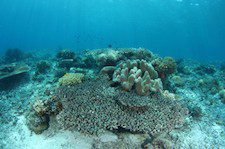 Often lost in the debate over climate change and CO2 emissions is the link between rising carbon dioxide levels and ocean chemistry. Since the early 19th century, scientists have understood carbon dioxide as a greenhouse gas. Late in the 19th century researchers began to suspect that CO2 emissions could alter climate. For at least the past three decades the link between rapidly rising greenhouse gas emissions and climate change has become established. But it has only been in the past few years those emissions could adversely affect the chemistry of the oceans, making ocean waters more acidic, with potentially catastrophic consequences for marine life
Often lost in the debate over climate change and CO2 emissions is the link between rising carbon dioxide levels and ocean chemistry. Since the early 19th century, scientists have understood carbon dioxide as a greenhouse gas. Late in the 19th century researchers began to suspect that CO2 emissions could alter climate. For at least the past three decades the link between rapidly rising greenhouse gas emissions and climate change has become established. But it has only been in the past few years those emissions could adversely affect the chemistry of the oceans, making ocean waters more acidic, with potentially catastrophic consequences for marine life
Scientists are now trying to quickly get up to speed with their understanding of the health and changes occurring in the world’s oceans. That is the general consensus (oh, that word!) from researchers attending the annual meeting of the American Association for the Advancement of Science last weekend.
To start, the National Oceanic and Atmospheric Administration (NOAA) plans to release its first ocean acidification research plan.
It’s going to be delivered to headquarters next month,” said Richard Feely, an oceanographer for the NOAA. “Our plan includes coastal observations, technology development, remote sensing using satellites, an observational network with moorings to measure CO2, [and] physiological research on how various organisms respond to changes.”
The National Academy of Sciences (NAS) is set to release a comprehensive congressionally-mandated research study by the end of March that will address scientific issues concerning the impact of ocean acidification on marine life as well as policy issues and recommendations for a national ocean acidification research program.
The Scripps Institute of Oceanography is also involved in studying acidification. Victoria Fabry, a member of the NAS panel and a visiting researcher at Scripps, says scientists are able to detect and measure changes in ocean chemistry from increasing levels of CO2.
A case in point is a 2007 research expedition led by Feely from the NOAA. Feely found corrosive waters off the Pacific coast of North America at levels not expected until 2050. It is apparent from observation that acidification is happening. The question then becomes to what extent it will continue, and that depends on the trajectory of CO2 emissions.
Today, the atmospheric CO2 concentration is about 388 parts per million,” said Fabry. “This is the highest that it’s ever been in the past 800,000 years — as far back as the record goes right now. And there are concerns about where we’re headed.”
Oceans absorbing CO2 at an increasing rate
Oceans have absorbed about one third of humanity’s CO2 emissions since the start of the industrial revolution, leaving them 30 percent more acidic than before the fossil fuel revolution. Given a business-as-usual scenario, that will increase to 150 percent by the end of the century, imperiling sea life that grow their hard shells from calcium carbonate, including oysters, corals and plankton. As the ocean becomes more acidic, it dissolves those hard shells. Eventually at a rate faster than the creatures are able to rebuild them. It’s a phenomenon that scientists fear could move up through the food chain.
Questions over the ability of some coral’s ability to resist and adapt to changing conditions underscore the need for continued and ongoing research. To that end, developments in tools to monitor ocean acidification are progressing apace.
The new tools and prospects for a coordinated federal ocean acidification research program are welcome news and hopeful signs for scientists and researchers working to monitor the health of the world’s oceans and better understand the consequent changes of increased CO2 levels.
Sources:
ClimateWire (subscription required)


